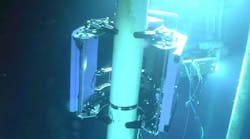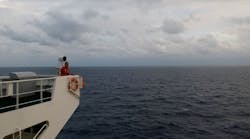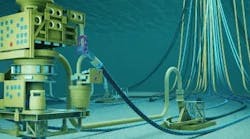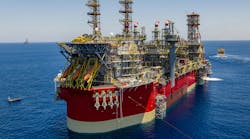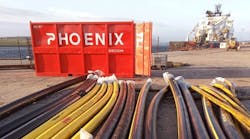Use of 3D-seismic surface amplitude mapping has proved to be a rapid and reasonably accurate method of identi-fying seafloor areas affected by fluid and gas expulsion. Through limited ground truth observation and sampling of amplitude anomalies using manned submersibles, links have been made between several different seafloor types and hydrocarbon seepage-to-venting. The two examples presented in this paper are those of areas affected by distinctly different seep rates and therefore, quite different resulting seafloor responses.
For the first time, the complex continental slope opposite Louisiana is covered with a high quality database, other than bathymetry (multibeam), for interpreting seafloor geology. This database consists of large, adjacent, and overlapping tracks of 3D seismic data. The Minerals Management Service (MMS), in cooperation with university personnel, is utilizing these reasonably uniform data in conjunction with other supporting data sets to help improve interpretation of seafloor geology and biology for regulatory purposes. The MMS has access to all seismic data permitted in federal waters.
Of particular interest is the reliable identification of (a) geohazards associated with areas of fluid and gas expulsion, (b) sites of lawfully protected chemosynthetic communities, and (c) identification at the seafloor of proven hydrocarbon-trapping faults. Initial results indicate that 3D seismic surface amplitude data calibrated to high resolution acoustic data, as well as direct seafloor observations and samples, are powerful predictors of surficial geology and, to a lesser extent, biology of the slope. Surface amplitude data can determine hard lithified bottom, compared with soft gas-charged surface and near-surface sediments. Faults, fault trends, and some mass movement features are also imaged by surface amplitude data. MMS-sponsored field research and geophysical interpretation indicates that there is a good correlation between 3D amplitude response and the occurrence of chemosynthetic communities.
Observational data from manned submersibles suggests that the occurrence of these communities correlates with gas hydrates at the seafloor or in the very shallow subsurface. Additionally, there is a high degree of correlation between the location of the seafloor amplitude anomalies and the location of proven hydrocarbon trapping faults that cut the seafloor.
Deepwater studies
Of the 83 fields studied in the deepwater Gulf of Mexico to date, all 60 that are trapped by faults that cut the water bottom have variable strength seafloor amplitude anomalies associated with them. Those fields that do not have amplitude anomalies associated with them are either stratigraphically trapped, subsalt accumulations, or trapped by buried faults.
Over the next three years, this MMS-funded research program is designed to establish improved links between remotely sensed 3D-seismic surface amplitude data and actual sea-floor conditions, so that amplitude data can be used as a reliable predictor of surficial geology-biology of the northern Gulf continental slope.
Within the MMS units that evaluate geological and geophysical data for resource evaluation, leasing, and protection of sensitive biological communities, there is a growing need to use the most up-to-date data sets, like 3D seismic, to provide a new dimension of understanding of the modern seafloor.
Exploration has pushed oil and gas activity beyond the upper continental slope to the deepest limits of the slope and the adjacent deep basin floor, where traditional high resolution acoustic data sets are costly and difficult to collect. Therefore, more and more reliance is being placed on 3D seismic data to provide an accurate and insightful appraisal of the seafloor and shallow subsurface. To date, 84 large 3D data sets have been mapped over most of the Louisiana-Texas continental slope.
The data are currently being evaluated by MMS personnel in an effort to produce more useful information for interpreting the slope's modern seafloor and the hydrocarbon-productive subsurface beneath it. The driving force for analysis of the seafloor is to identify potential geohazards and areas that have hydrocarbons seeping or being vented into surficial sediments, where they may provide the basic trophic resources for densely populated and lawfully protected chemo-synthetic communities.
Surface amplitude mapping
A very promising approach to using regional 3D seismic data for enhanced predictability of seafloor geology and biology, as well as configuration of the shallow subsurface, is surface amplitude mapping. This technique is valuable for quickly mapping large areas of seafloor and identifying those local zones that differ in reflection strength from ambient conditions. However, a variety of conditions can account for amplitudes that deviate from the "norm." These conditions range from hard bottoms associated with rock outcrops, (mineralized mounds, reefs, hard grounds, and other cemented bottom types) to very soft bottoms that are charged with gas (biogenic, thermogenic, or a combination of the two). The hard bottom areas constitute a medium through which acoustic energy travels slightly faster than the surrounding seafloor, while gas-charged sediment have just the opposite response of slower velocities.
The objective of the work described in this paper is to improve the utility of 3D seismic surface amplitude mapping by "calibrating" these data sets against known seafloor conditions.
Data sets, methodology
The basic data sets used in this study consisted of 3D seismic acquired in large areas of both the Garden Banks and Green Canyon lease block areas. In most 3D data sets, the seafloor reflector was strong and well suited to the automatic picking program on a seismic workstation. The seafloor horizon was given a unique, consistent name for each survey to prevent amplitude display problems caused by the wide variation in amplitude scaling between surveys. Every seafloor horizon was defined as a positive (compressional) event in the horizon settings. The number of seed lines interpreted was dependent on the complexity and rugosity of the seafloor. Upon completion of the automatic picking process, the interpreter then quality-checked the resulting interpretation for bad picks and gaps. Hand picking, though uncommon, was necessary in some high dip and complex areas. Two study sites were used in this investigation - Garden Banks Blocks 387 and 388 and Green Canyon Blocks 140 and 184. Data sets consisting of high resolution seismic, sidescan sonar, cores, and direct observation-sampling using a manned submersible were used to calibrate 3D-seismic surface amplitudes to seafloor geology and, to a lesser extent, biology.
Garden Banks 387/388
The site survey work submitted to MMS for the Plan of Development (POD) for Garden Banks Blocks 387 and 388 (Cooper Field) included numerous core samples and direct seafloor observations using a submersible. A zone within the survey area was delineated with the core data consisting of gas/oil saturated muds and hydrates. This zone occurred along a series of semi-parallel deep faults that cut the seafloor. This fault system was the trapping fault for the Cooper Field.
Using 3D seismic coverage, MMS personnel mapped the seafloor amplitudes of this area. A mound containing gas hydrates approximately 335 meters in diameter observed during submersible operations was clearly discernible on the 3D seismic amplitude map. Just southeast of the mound, a conical seafloor depression some 150 meters in diameter was also discernible on both the 3D seismic data and the amplitude map.
Seafloor amplitudes in the depression were high negative compared to the anomalously high positive seafloor amplitudes of the area surrounding it (phase reversal). Comparing the seafloor amplitude map to the POD map, the area of high amplitude corresponds extremely well to the area described as the limit of gas/oil charged sediments and hydrates.
Two cores taken within the seafloor depression (with its much lower amplitude) were described as gas and oil saturated mud, indicating that the depression could possibly represent an active vent. It is surmised that venting could be introducing warm fluids (connate water and hydrocarbons) from depth, which would prevent the formation of hydrates at the immediate vent site. Further investigations with a submersible are planned for this site during 2000.
Green Canyon 140/184
The Green Canyon Blocks 140 and 184 area is underlain by a saddle-shaped salt mass that penetrates to within about 400 meters of the seafloor under Green Canyon 140, but another mass beneath the Jolliet Field in Green Canyon 184 is much more deeply buried. Fault pathways over the Jolliet Field developed into deep-cutting networks that tap hydrocarbon-rich subsurface horizons.
The large mound with known gas-hydrates and abundant chemosynthetic communities ("Bush Hill" - Green Canyon 185) is fed by this fault system. By contrast, the thin sedimentary column above the salt mass in Green Canyon 140 is broken by numerous faults having limited access to overpressured zones of the deep subsurface and a source of hydrocarbons.
Bathymetric and high resolution seismic profiles, as well as swaths of sidescan sonar data, clearly indicate that the crestal areas of the Green Canyon 140 dome are characterized by numerous mound-like buildups that vary in relief from a few meters to over 20 meters. The flanks of the Green Canyon 140 dome are draped with fine-grained hemipelagic sediment varying in thickness from approximately 2 meters to over 6 meters.
On the top of the dome, however, the hemipelagic drape is missing, and the seafloor is characterized by complexes of mounds that are clearly visible on high resolution acoustic data sets. On exploration-scale 3D seismic, the surface mounds are below the resolution of this low-frequency source and are therefore not clearly resolved. Although it is sometimes difficult from seismic and bathymetric profiles to determine if the dome-top mounded surface is composed of a series of lithified buildups or multiple mud volcanoes, the complex structure of individual buildups as viewed on sidescan sonar data suggests that they are not smooth-sided mud extrusion features.
Submersible observations from the crestal area of the Green Canyon 140 dome clearly indicate that the mounds occupying this area are composed of authigenic carbonates. Laboratory work on these carbonates indicates that they are extremely depleted of carbon 13, indicating an origin linked to the microbial utilization of hydrocarbons.
The mineralogy of the carbonates in Green Canyon 140 is primarily Mg-calcite with some dolomite. The buildups, 20-100 meters in diameter and up to 20 meters high, are composed of chaotically oriented blocks and clasts. Surr-ounding sediments can be quite coarse, containing a high proportion of diagenetic clasts and shell debris.
The mounds are cut by fractures and crev-ices probably related to post-mound movement of underlying salt. Only a single rudimentary community of chemosynthetic organisms is found at this site, living on products expelled through a deep crevice. Evidence of gas or crude oil leaking into the water column is not present in the Green Canyon 140 area, although the presence of both is indicated by the authigenic carbonates. This area appears to have been one of very slow seepage over a long period of time. Radiometric dates of the buildups indicate some mounds date at nearly 200 kyr BP.
Mapping of 3D seismic surface amplitude data clearly identifies the area of hard bottom that correlates to mounded carbonates identified on sidescan swaths, high resolution seismic profiles, and direct observations acquired with a manned submersible. The (a) significant surface amplitude shift away from the character of the surrounding seafloor, no phase reversal across the dome crest on the 3D seismic profiles, (b) a highly reflective and mounded surface on high resolution seismic, and (c) the discrimination of complex mounds with irregular surfaces and well-defined and steep sides on sidescan sonar data, identify these features as lithified buildups, as opposed to mud mounds or other sediment-derived topographic features.
Submersible ground truth and subsequent laboratory work on mound samples confirm that these features are by-products of microbial degradation of hydrocarbons delivered to the surficial sediments slowly and in small amounts. As a general statement, these features in Green Canyon 140 are not associated with gas-charged sediments or chemosynthetic communities.
Summary
In the Garden Banks Blocks 387/388 case, fluids (formation fluids, crude oil, and fluidized sediment) and gases are arriving at the sediment-water interface rather rapidly, resulting in an interpreted mud vent and areas of near-surface gas hydrates.
The seafloor response in the very slow hydrocarbon seepage area of Green Canyon Blocks 140/184 contrasts sharply with the Garden Banks example. Here, the microbial utilization of hydrocarbons has produced mounded carbonates as a by-product. By using 3D seismic surface amplitude mapping, these two types of seafloor produced by fluid and gas expulsion are clearly identified as being different from surrounding areas.
MMS personnel have mapped 3D seismic surface amplitude anomalies over most of the northern Gulf of Mexico continental slope. Research is now underway to collect ground truth data from a critical number of these anomalies in an effort to improve our predictability of both associated seafloor geology and biology.



